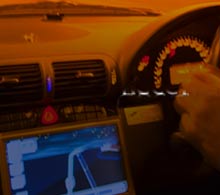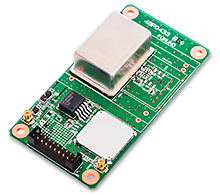Articles for ITS market The Automobile industry is shifting from a manufacturing industry to a service industry.
TOYOTA’s new model, "Prius PHV" brings connecting to “another dimension”
On February 15 Toyota released a new model, the "Prius PHV" which will be a full model change for the first time in five years. At the press conference TOYOTA emphasized the five evolutions of the "different dimensions".
The five evolutions are EV traveling, charging system enhancements, safety technology, design and power supply functions.
To explain step by step, the running in EV mode achieves 68.2 km / L which is more than twice the first Prius PHV. The lithium-ion secondary battery which can be installed has been expanded to 8.8 kwh.
With the enhancement of the charging system, it also supports rapid charge using direct current.
In safety technology, Toyota Safety Sense P is installed. It will improve the function of the collision damage mitigation braking system which is also called automatic brake. It will also automatically correct steering when approaching a lane departure situation.
Regarding the design when compared to the previous "Prius", the design of the front and rear of the car body was changed significantly, emphasizing the advanced product image.
For the power supply function, 100 V power supply can be used with a maximum output of 1500 W.
Toyota explains that these five different dimensions of evolution will be connected.
"Connected" refers to the connection between the onboard device and the cloud. It is a system that transmits information as needed to the car based on collecting and analyzing big data results. This includes sharing such data as operating condition of car, operating history, etc. with the "Toyota Smart Center".
"How to connect" between the car and the outside? There are two ways.
First by using smartphones. In this case the basic usage fee is free, with the customer being responsible for smartphone packet communication charges. The second is a dedicated in-vehicle communication device called “DCM” (Data Communication Module). In the new "Prius PHV case", it is equipped with a large 11.6 inch HMI (human machine interface). Packet communication is unlimited in the basic usage fee for 3 years, afterward the charge is 12,260 Japanese yen per year.
Today, the information and communication service TOYOTA offers to the general public is called "T Connect".
Major functions include "map on demand" by OTA (over the air) which automatically communicates navigation map information updates. "T route search" performs optimum route searching, taking into consideration information from other mobile Toyota vehicles, traffic information such as VICS (Vehicle Information and Communication System) and statistical data. "Agent" performs advanced speech recognition via an on-vehicle device or by using the cloud, "My car security" tracks vehicle theft and also provides other features.
Discussion on overall "monetizing (billing)" plan by utilizing big data
TOYOTA has revealed that DCM would be installed in all new cars. Including gasoline-powered vehicles such as compact cars and minivans and also electric vehicles such as the "Prius PHV".
Big data will play a leading role in all future automotive business.
Nonetheless the discussion of how "big data" can be "monetized (billed)" is not just at TOYOTA. All automobile manufacturers are developing similar plans.
By constantly monitoring vehicle operations and travel all automobile manufacturers are able to respond quickly to repair an event or failure. By sharing data with insurance companies it will be possible to optimize automobile insurance. There are also many other applications possible.
On the other hand, adding the DCM hardware and associated communication cost (for first 3 years) squeezes new car profits.
In the discussion car manufactures are starting to understand the difficulty of transitioning from the current business model of automobile manufacturing and sales.
In other words, it is necessary to significantly change the structure of the automobile industry, and as a result automotive companies must reorganize many aspects of their business.
Big data creates a new service industry within the automobile industry
 An image about the automatic driving of German map maker "HERE."
An image about the automatic driving of German map maker "HERE."
 Mitsubishi "OUTLANDER PHEV" is improved and supports apple "car play"and Google "android auto".
Mitsubishi "OUTLANDER PHEV" is improved and supports apple "car play"and Google "android auto".
So, what kind of organizational changes will be required? A shift from only manufacturing to now include service. The automobile industry has been a product-out type industry, mainly concentrating on manufacturing. In a slightly pessimistic view it was a business concentrating on "promote selling, without considering services after the sale".
Automobile manufacturers plan and manufacture new cars. Although they are sold by dealers, sharing of customer information has not normally been shared between dealers and manufacturers.
In addition dealers often have contact points with customers only during periodic inspections, vehicle inspections, etc. And so the cycle of "promote selling, without considering services after the sale continues." In a study, data shows that new car customers of one manufacturer’s dealer had reduced their dealer service/repair interval to only 10% by the eight year of ownership.
This type of situation changes greatly with the introduction of big data. This is because automobile manufacturers can now access information directly from the customer’s automobile and collect personal information such as driving behavior, type of travel, food and drink, music preference, etc.
In other words the dealer has the risk of becoming "Just a repair shop", and it is also thought that the existence of many dealers will be threatened. Therefore in promoting the utilization of big data, automobile manufacturers will inevitably need to "reconstruct the relationship" by providing new contracts to dealers. Naturally some negative feedback is expected from the dealer network.
In addition it is an opportunity for enterprises entering the core big data business including major IT companies to enter the automobile industry during this reorganization period.
Writer introduction

Mr. Kenji Momota Automotive journalist
His major is the world automotive industry and he is also familiar with the energy industry, IT and the aging society problem as the related fields. He acts around the world based in Japan and USA and writes for the general magazines, the technology journals and the automotive related media etc.
He is also commentator of motor race and world's motor show on TV program based on his career of the driver of Indy Racing League and NASCAR. In recent years, he has been covering about a paradigm shift from developed countries to developing countries, the motorized vehicle like EV and the telematics.
FURUNO ITS Journal
Click here for the latest articles after 2022 (in Japanese)2022
- The "realistic" self-driving roadmap shown by the Japanese government and a hands-on report on the latest Subaru EyeSight X
- Will FCVs (Fuel Cell Vehicles) Become Popular? ~New Movement in Toyota and Honda~
- The 'Complete' online sales of new cars start in Japan. Will this new way of buying cars take root?
- Many Firsts! On-Site Report from Tokyo Auto Salon 2022 - The author, who knows what goes on behind the scenes, looks back on 40 years of history. -
2021
- "Moving toward zero traffic fatalities for four-wheeled and two-wheeled vehicles globally in 2050" ~Experience on Honda's latest safety technologies~
- Tsuneishi Shipbuilding's building and DX, an exclusive visit to the main factory
- Japan's Smart City: New Moves toward Practical Use
- When will self-driving buses (service cars) be put to "full-scale" practical use?
- Utilization vehicle data during disasters
- Toyota-led Connected Technology to Transform Commercial Vehicle Business -From light trucks to large trucks and buses-
- Toyota enters the connected car "Personalization" business
- Japanese automakers' carbon-neutral strategies swept up in ESG investment
- Drive experience of the latest autonomous vehicle models and advanced driving support systems
- Will carbon neutrality accelerate the trend to strengthen LCA (Life Cycle Assessment)?
- Semiconductor shortage exposes realities of the automotive industry
- Online Autonomous Driving Contest Enhancing development of Human Resources
2020
- What happens to CASE when gas cars are banned in Japan?
- When will Flying Cars be launched?
- Expectation vs. reality:Autonomous Driving in Japan
- V2X, Becoming increasingly important in autonomous driving
- Technology of Subaru “EyeSight X”
- Lifestyle-oriented French cars gain popularity in Japan
- Human-oriented smart cities are wanted
- MaaS and CASE, how would automotive industry change after COVID-19?
- The beginning of virtualization era, triggered by COVID-19
- Trend of EV shift and consumer demands
- TOYOTA Press conference about ADAS - Releasing algorithm for "sudden acceleration suppression during attempted sudden acceleration" free of charge -
- The Japanese automotive industry in 2020 - 3 turning points -
- "Using a smartphone while driving" and "Level 3 automated driving"
2019
- Motor show business model is at a turning point - Tokyo Motor Show Report -
- Commercialization and monetization of MaaS - ITS World Congress Singapore Report -
- Android Automotive pays attention to V2X - Report from the Frankfurt Motor Show 2019 in Germany -
- Automobile Distribution Revolution and DCM (Data Communication Module)
- Connected business potential and newly proposed "eMaaS" by Honda
- 5G services for practical use are multiplying
- Connectivity technologies attracting attention due to frequent traffic accidents
- Shanghai Motor Show report -SUV, EV, Automated car & 5G-
- Drone Business roadmap and updates to Michibiki (Quasi-Zenith Satellite System)
- MaaS (Mobility as a Service) "town development." Full-scale promotion for a national project
- CES organizer states "Data Period in 2020s." Transformation of the Automotive Industry in CES, US "-CES2019 Report-"
- "Return to Origin" directed towards the age of change, automatic operation and connectivity
2018
- New proposal for Private Car Automated Driving Level and other Hot 5G Technology Topics
- Standardized EV charging infrastructure concerns in Europe, US, Japan and China - Kobe EVS 31 field report -
- Touring a pure car carrier and a test drive of the latest hybrid car
- Planning stage products are exhibited at the newly established visualized mobility service "TOYOTA MOBILITY SHOWROOM".
- Potential “Community Car-share” program promoted by local residents
- CES Asia Report 2108
- Companies attempt new Vehicle-to-Infrastructure communications, including traffic volume measurements and vehicle positioning. -ITS Asia Pacific Forum in Fukuoka-
- Geneva show in Switzerland. Flying cars and MaaS (Mobility as a Service) were hot topics.
- EV (Electric Vehicle) proposals by country
- MaaS competition through service mobilization, M & A and technical field collaboration is accelerating. - The CES 2018 Report -
2017
- Big data’s initiative and fight for the automotive industry. Cooperation among companies becomes increasingly important.
- Connected car and road-to-vehicle communication automatic operation
- ETC (Electronic Toll Collection) and ETC2.0. Current situation and projected future
- Rapid development of sharing economy
- Germany is first to recognize level 3 automated driving
- ITS EU 2017 Field Reports -Automatic Operation and the eCall-
- From Infotainment to ITS, the competitive area is spreading in the car big data industry.
- GTC (GPU Technology Conference) Report and the de facto standardization of AI (artificial intelligence)
- Renesas' new challenge! "e-AI Solution" and "Renesas Autonomy"
- The Automobile industry is shifting from a manufacturing industry to a service industry.
- The movement toward accident countermeasures for aging drivers in Japan
- Fusion of ride sharing and fully automated driving is advancing in the USA.
2016
- Overview of the Quasi-Zenith Satellite System (QZSS) and advancements toward full-scale practical use including the Tokyo Olympic Games - G-space EXPO 2016 report-
- Japan’s automated driving project "SIP-adus" will be a large demonstration experiment.
- The International Home Care & Rehabilitation Exhibition. There were many car manufactures with exhibits booths at this show.
- Japanese car manufacturers starting to concentrate on strengthening the ADAS system
- A new movement of legislation for autonomous cars
- Cyber Security and “AGL”, the new OS for automotive are hot topics in the connected car industry
- “High precision 3D map” the key future of autonomous car and pedestrian dead reckoning
- Chinese “BAT” is accelerating their business in the EV (Electric Vehicle) market
- Tesla's original connection to Taiwan and the new transportation system technologies.
- "The main topic" of the Geneva Motor Show was how to strengthen "pedestrian protection"
- The probe data business is getting more competitive
- Reporting directly from the 2016 CES show "Data services will soon become the main revenue source of automotive industry"
2015
- Do the automated driving systems need the GNSS (Global Navigation Satellite System) ?
- ETC Version 2.0 is coming soon. A new service was announced at the Tokyo Motor Show and the possibility that is could be used as a device for older drivers.
- "Connected Horizon" and "eHorizon". Germany's leading parts supplier accelerates strengthening of "Big Data" for business



 The demonstration of the new "Prius PHV", shows how we collaborate "connect" to various functions and designs.
The demonstration of the new "Prius PHV", shows how we collaborate "connect" to various functions and designs. Picture of large HMI available in the new "Prius PHV". The size is the largest domestically available in Japan at 11.6 inches in length.
Picture of large HMI available in the new "Prius PHV". The size is the largest domestically available in Japan at 11.6 inches in length. Information displayed on the "Prius PHV" on-board unit. Various traveling information is transmitted and received via the cloud.
Information displayed on the "Prius PHV" on-board unit. Various traveling information is transmitted and received via the cloud. GPS/GNSS Receiver&Chips and Modules (positioning and timing)
GPS/GNSS Receiver&Chips and Modules (positioning and timing)